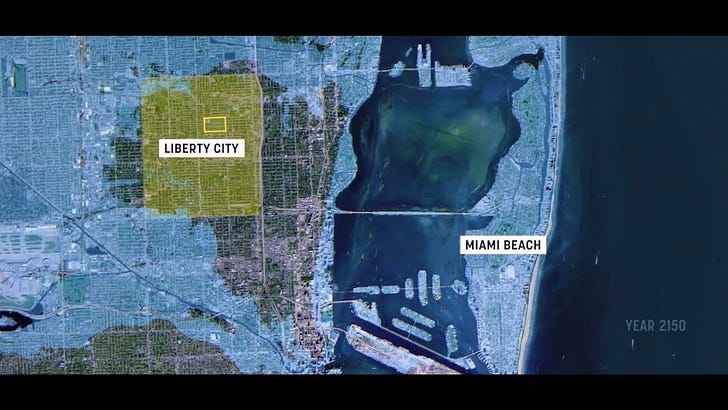This post goes out to both free and paid subscribers, but if you are not already a paid subscriber and value this effort and our growing community, please consider upgrading to a paid membership. But wait, there’s a sale going on at The Poverty Trap! For all NEW yearly Suscribers and NEW founding members, you will get 20% off if you sign up today through February 29, 2024. Thanks in advance for your financial support of my work —it’s what allows me to keep researching and writing.
Trailer for “Razing Liberty Square”, a documentary directed by Academy-Award nominated filmmaker, Katja Esson, a resident of Miami, Florida. It premiered on PBS on January 29, 2024. You can read more about the film and the film makers here.
A government report, The Indians of Southern California in 1852, explained that many Californians believed "destiny had awarded California to the Americans to develop" and that if the Indians "interfered with progress they should be pushed aside." The Library of Congress
Pushed aside. People, land, animals, waters, trees — all have been bulldozed, re-routed, displaced and yes, pushed aside for “development” of the land — what some believe is “progress”. Progress, though, tends to favor already wealthy developers at the expense of low income people and their communities. Displacing America’s indigenous peoples was one of our country’s founding principles justified by the colonists’ and later our government’s belief in “manifest destiny”. President Andrew Jackson signed The Indian Removal Act in 1830, “…which empowered the federal government to take Native-held land east of Mississippi and forcibly relocate Native people from their homes in Georgia, Alabama, North Carolina, Florida, and Tennessee to “Indian territory” in what is now Oklahoma.” This forced removal is known as “The Trail of Tears, where tens of thousands of Native Americans either died or were killed.
And from the government’s perspective, it worked — those without power were removed from their land, and the many and varied cultures of the indigenous tribes were erased along with their people.
This pattern of displacement continues to be repeated with the “gentrification” of neighborhoods throughout the country. Clearly, there is not a direct comparison of a forcible removal of people from their land to reservations on the other side of the country where tens of thousands and then millions died, to gentrification of individual neighborhoods, but the common result is forced displacement of marginalized people, including the poor and people of color.
In the last decade, though, climate change has become an additional catalyst for gentrification of predominately minority and poor communities. Here is a general definition of climate gentrification from an interview with the director of “Razing Liberty Square” in Orion Magazine. The interview/article is aptly titled “Stealing Higher Ground: A Portrait of Rising Climate Gentrification”. You can read the full interview here.1
Climate Gentrification: the process by which the impacts of climate change, such as rising sea levels and increased temperatures, contribute to the displacement of low-income communities and the transformation of neighborhoods, often driven by increased investment and redevelopment in less climate vulnerable areas.
The film focuses on a four square mile area about six miles north and west of downtown Miami, Florida, called Liberty Square, which was one of the first public housing projects built in the United States (1937) for Black people. It sits on some of the highest ground in Miami-Dade county, approximately 15-16 feet above sea level. At the time it was constructed, Miami’s beach front was whites only, and Liberty Square was a safely segregated distance from the wealthy whites on the shore.
In 2019, then Secretary of Housing and Urban Development (HUD), Ben Carson, attended a ribbon cutting ceremony for the opening of the first phase of the redevelopment of Liberty Square, touting a federal, state and local partnership of funding and planning to make this redevelopment happen. The local news video and article paint a rosier picture of the demolition and first phase of the rebuilding than does the documentary, “Razing Liberty Square”. The impacts of climate change are not lost on real estate developers, and they began to calculate the high cost of living ocean front, including soaring home insurance premiums. And the developers knew they had a built-in market — the home owners living on drained swamp land and borrowed time. The developers, along with government funds and wealthy homeowners set their sights on poor communities like Liberty Square, just a few miles away, and relatively speaking, on higher ground.
According to the Orion Magazine interview with the documentary’s director, Katja Esson, the redevelopment of Liberty Square did not benefit its long-time residents:
The promise was to do a block-by-block approach. All the people from the first block would be moved into empty units that existed on site. Then demolish and build the first block and move the people into the new units. And so on. That was the promise, not to displace anybody. But then the film witnessed how promises were broken.
In fact, statistics released by HUD last year show that only five families of the 640 living in Liberty Square when the redevelopment began have returned to claim the new housing. The “why” is not answered in the film, but Esson believes that the story is not over.
We are trying to change the outcome of the story we are telling through the film, because only 3 of the 9 blocks of the new Liberty Square are complete, which means with enough visibility, how these next blocks are built, could (and should) be different. We also hope the film will support residents’ ongoing fight for the things they were promised: like a new building for the MEYGA learning center, and quality apartments, respectful management, and so on.
We want to share this story as an intervention in the affordable housing sector and look to (or create) housing that is truly affordable to longtime residents and is not intended to displace anyone.
The Liberty Square “demolish and redevelop” project is likely a continuation of HUD’s longtime promotion of mixed income communities. In 1992, HOPE VI was signed into law which allocated $5 billion to demolish blighted public housing (where only poor people lived), and to rebuild communities that included people with different levels of income to “decentralize poverty and revitalize urban neighborhoods”. And to some degree, this program accomplished its goal. According to a Congressional report published in 2012, the first year after all funding expired for HOPE VI:
Over the history of the program, 268 HOPE VI revitalization grants (including Main Street grants) have been made to [ local Public Housing Authorities] PHAs in 41 states, districts, and territories. As of June 2009, the program had been responsible for the demolition of 93,295 units of public housing and the construction or substantial rehabilitation of 78,692 replacement units.
But these numbers have underlying costs —costs to people and their communities —that are perhaps better told through stories highlighting real people, like Esson’s film, “Razing Liberty Square”. One person the film focuses on throughout is Aaron McKinney, Development Coordinator for the private company, Related Urban Development Group which was awarded the contract to redevelop Liberty Square, where McKinney was born and raised. When talking with a group of Liberty Square residents, he says: “ I believe concentrated poverty doesn’t work.” And that was one of the main prongs of the HOPE VI projects — break up poverty clusters so poor people can see a way out. McKinney eventually resigned his position with Related Urban and continues to do community work in Liberty Square.
Here’s another take on that idea. James Tracy, a prolific writer and activist, wrote an in-depth critique of the HOPE VI program for REIMAGINE Journal titled “HOPE VI Mixed Income Housing Projects Displace Poor People”. This is what he said about governments trying to break up areas it deems concentrated poverty pockets, which Tracy describes as “Spatial Deconcentration as Political Diffusion” :
In other words, poverty is a result of poor people living in close proximity to each other—rather than of structural unemployment or the persistence of racism—and “economic integration,” or living close to employed people, will set a good example for the poor.
Is spatial deconcentration a progressive solution to poverty or a hideous experiment in social engineering? One obvious effect of spatial deconcentration is the dilution of the political power wielded by concentrated voting blocks. The other is that it makes more difficult any political organizing for the common economic interests of a community.
__________________________________________________________________________
What are your thoughts on these issues? Have you seen the documentary, “Razing Liberty Square”, or will you now? Climate gentrification? Spreading out the poor via government policy and programs? Mixed-Income Neighborhoods? Please comment below!
If you like this post, please
And/Or
Thanks!
Jill Tidman, the interviewer, is the Executive Director of The Redford Center, an environmental non-profit founded by Robert Redford and James Redford, whose mission is “Advancing environmental solutions through the power of stories that move.”. Both The Redford Center and Sundance, among others, provided funding for “Razing Liberty Square.”













Share this post